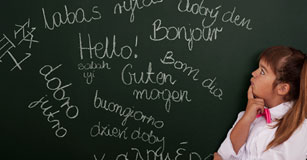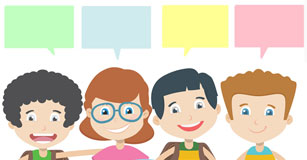Five Habits for Great ELL Instruction
Cultivate these instructional habits to support English language acquisition

Nearly all classrooms in this country now include English Language Learners. While many schools are fortunate to have both instructional coaches and classroom teachers who focus on this student population, many educators who do not have formal training are encountering these learners as well.
Even if you don't have formal training in ELL instruction, there are things you can start doing right now to support your second language learners.
1. Use visuals.
Let's start with an obvious way to differentiate to support ELL students: visual aids. Images can be interpreted without the need for any language ability, providing a bridge to understanding for students who are currently unable to grasp meaning through written and spoken language.
Visuals also support learning for a range of students. Images help all learners more easily activate prior knowledge. Diagrams and charts make accessing meaning simpler. Dual coding also helps students better interpret information and retain meaning.

Visuals help you provide non-verbal clues to the meaning of both spoken and written language, so it is helpful to include pictures when you are speaking as well as providing written information and directions.
Teaching History has a great page with specific examples of how you can use visuals to build understanding of history for second language learners.
As you develop your instruction, consider how you can include illustrations, photographs, diagrams, charts, and graphs.
2.Provide opportunities for students to produce authentic language.
Everything you know about great literacy instruction applies to second language learners, but you do not have to focus solely only on vocabulary, fluency, and comprehension to support the language learners in your classroom.
Rote drills and worksheets will not lead students to second language mastery. Lecturing about the structure of language doesn't help students acquire it or grow in their ability to produce it. Students need authentic opportunities to practice.
Make the work in your classroom meaningful, both educationally and personally, so that students want to participate. Digital authoring tools like Pixie and Wixie provide opportunities for students to explore content and demonstrate understanding using a combination of images, original artwork, text, and narration. Creating multimedia products provides a fun way to have students practice listening, reading, speaking, and writing.
You might consider asking second language learners to contribute a single page to a larger class book. In elementary grades, this might take the form of a cloze style retelling or adaptation; in secondary grades, it could be a haiku shared a class book of poetry.
Collaborative projects provide language learners with opportunities to watch, listen, and communicate with peers. The shared product they create for others to view engenders a sense of pride in their contributions and an opportunity to practice and apply the content and language skills they have acquired.
As you develop your instruction, consider how collaboration, creativity, and digital tools can help you make students' work more meaningful.
3. Differentiate.
You already consider the diversity of learners in your classrooms and capitalize on this knowledge as you plan, implement, and evaluate your instruction. Differentiation for ELL students should go beyond merely classifying them all as second language learners.
Most ELL researchers agree that second language learners progress through an identifiable “continuum of learning.” These identifiable stages of language acquisition allow us to predict what students are able to do (Krashen's Natural Order hypothesis).
It is important to ask learners at each stage of language acquisition to produce language differently.
- The Silent/Receptive Stage (Preproduction)
Students are non-verbal, so use images, expressions, and gestures to facilitate communication. - The Early Production Stage
Ask yes/no and either/or questions students can answer with one or two words.Item 2 - The Speech Emergence Stage
Have students produce language using simple sentences. Don't focus on grammar or structure. - Intermediate Language Proficiency Stage
Encourage students to ask questions and express opinions. Provide support for academic language. - Advanced Language Proficiency Stage
Build proficiency for these nearly native speakers with writing and complex ideas.
Learning more about the stages language acquisition can make it easier to identify a student’s current ability and modify your instruction to help them progress. It will also help you avoid misidentifying a student's limited language proficiency as an inability to think.
Modifying content, process, and product for these stages does not mean simplifying the content or lowering your expectations. Setting high expectations is crucial to success, and maintaining a focus on thinking skills helps these students make educational progress while they acquire a second language.
As you develop your instruction, consider how students at different stages can approach similar content.
4. Think about what you say and how you say it.
You know your content. Most educators are passionate about what they teach. But how often do we think about our audience when we tell it? Are we speaking in a way that is comprehensible to our students?
To paraphrase Stephen Krashen's Input hypothesis, language learners make the most progress when they are able to understand language that is slightly above their own language ability.
Connect to and engage learners using language they understand, and build on the language they known to push them a little further.
You can see this in practice by observing how parents speak to young children. They start by naming things, holding or pointing to an object, and saying “ball.” Next, they begin to describe it: “You have a red ball.” A parent will continue to add variations to introduce new vocabulary and structure:
“Get the ball.”
“Pick up the ball.”
“Bring me the ball.”
“Can you bring me the ball?”
“Can you bring me the ball, please?”
“Can you please bring the ball to me?”
As you use written and spoken language in your classroom, consider what students are able to comprehend. Again, being able to identify stages of language acquisition will help you differentiate and communicate appropriately.
As you develop your instruction, focus on using high-impact vocabulary and modeling correct language.
5. Show you care.
To paraphrase Krashen's affective filter hypothesis, a learner's ability to acquire language is influenced by how they feel. When students are nervous or embarrassed, they put up their affective filter to screen out the things that cause discomfort. If they are not feeling receptive to language, how can we expect them to learn it?
In the words of Carol Ann Tomlinson, “I have to teach content to human beings and I have to know those human beings to teach that content well.” When students can see that we know them as human beings, and understand that we care about them, they are willing to listen more and take greater risks.
Producing language is intimidating for students who want to fit in and who worry that poor grammar or pronunciation will make them stand out. Work to find ways to reduce this risk. Create a culture of risk-taking where a class response to broken English will result in applause rather than ridicule.
Simple technology tools can also help. For example, headset microphones allow students the safety of private practice. With them, students can record, listen, record again, and practice producing oral language until they are ready to save and share the spoken words they want others to hear.
As you develop the culture of your classroom, consider how you can support and reward risk-taking.
Finally, take advantage of your enthusiasm and passion, the qualities that made you a great teacher in the first place, to reach out to and support the English language learners in your classroom.
















